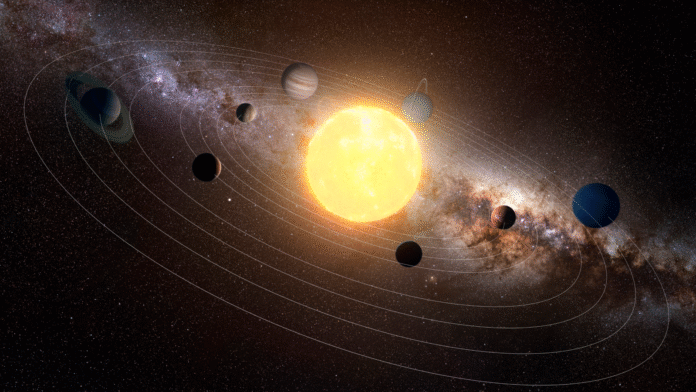"Dancing Through Time: How Earth’s Terrestrial Planets Once Waltzed in Harmony Around the Sun"
New Study Suggests Terrestrial Planets Once Danced in Resonance Around the Sun
Recent research has unveiled intriguing insights into the early dynamics of our solar system, suggesting that four terrestrial planets, including Earth and a hypothesized long-lost world, may have once orbited the Sun in a synchronized rhythm. This groundbreaking study, published on July 18 in The Astrophysical Journal, indicates that these planets formed earlier than previously believed, potentially reshaping our understanding of planetary formation.
The Dance of Resonance
Astronomers have long been fascinated by the concept of resonance in planetary systems, where planets exhibit orbital periods that are whole-number ratios of one another. This phenomenon has been observed in various exoplanet systems, such as the TRAPPIST-1 system, where the innermost planet completes eight orbits for every five of its nearest neighbor’s. In the case of our solar system, the current configuration of planets does not exhibit such resonance, although Venus and Mars come close with a 3.05:1 ratio.
The study’s authors, led by Shuo Huang, a doctoral student at Tsinghua University, utilized computer simulations to explore the early solar system’s dynamics. They modeled the interactions between two giant planets—Jupiter and Saturn—and four rocky worlds: Mars, Earth, Theia (a hypothetical planet believed to have collided with early Earth to form the Moon), and Venus. Notably, Mercury was excluded from the simulations due to its formation being attributed to giant impacts.
Methodology and Findings
The researchers conducted over 13,200 simulations over a 100-million-year period, examining how gravitational interactions influenced the planets’ movements. They found that in many scenarios, Venus, Earth, Theia, and Mars formed a resonant chain with a ratio of 2:3:4:6 within the first million years of the simulated time.
At the 10-million-year mark, the team simulated the outward movement of Saturn to reflect the giant planetary instability event that occurred approximately 4.4 billion years ago. This instability disrupted the resonant configuration, leading to the current arrangement of the terrestrial planets.
The results indicated that up to half of the simulations successfully recreated the current configuration of the terrestrial planets, including the significant Theia-Earth collision and the orbital-period ratio of Venus and Mars, which serves as a remnant of their past resonance.
Implications for Planetary Formation
The findings suggest that the terrestrial planets formed within a gas-rich protoplanetary disk, approximately 10 million years after the solar system’s inception. This timeline is notably earlier than current models, which typically estimate the formation of these planets to be around 20 million years later.
One of the key implications of this research is the potential for Venus to provide insights into the early solar system. Unlike Earth and Mars, Venus has not experienced significant giant impacts, meaning its mantle may retain clues about its ancient origins. Future missions aimed at collecting mantle samples could further illuminate the history of our neighboring planet.
The Role of Giant Planets
The study also highlights the destabilizing influence of giant planets on their inner companions. The authors propose that this dynamic may explain the absence of giant outer planets in resonant systems like TRAPPIST-1, where the inner planets are tightly packed and exhibit resonant behavior.
Conclusion
This new research not only sheds light on the early history of our solar system but also raises questions about the formation and evolution of planetary systems across the universe. As astronomers continue to explore the cosmos, understanding the intricate dance of planets may provide valuable insights into the conditions necessary for life and the formation of habitable worlds.
For more information, the full study can be accessed in The Astrophysical Journal.
